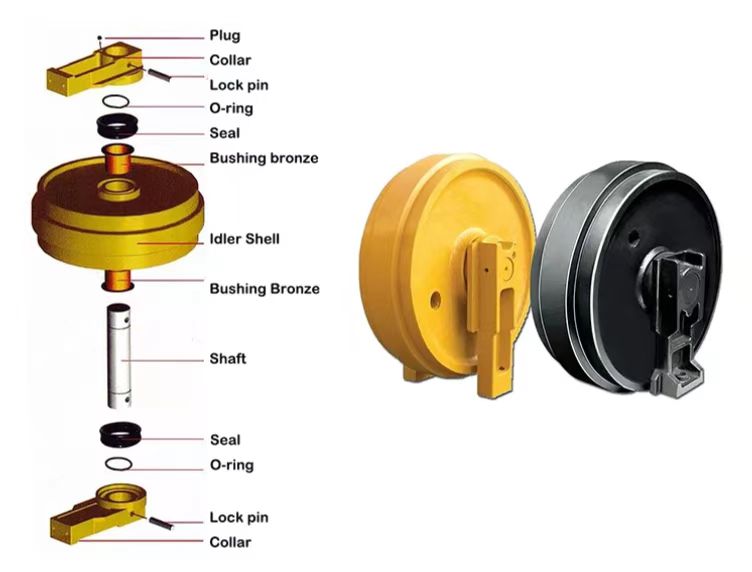Basic structure and working principle of excavator,Azerbaijan Excavator sprocket
1. Overall structure of single bucket hydraulic excavator
The overall structure of the single bucket hydraulic excavator includes power device, working device, slewing mechanism, operating mechanism, transmission system, traveling mechanism and auxiliary equipment, etc.
The commonly used full slewing hydraulic excavator’s power unit, the main part of transmission system, slewing mechanism, auxiliary equipment and cab are all installed on the slewing platform, which is usually called the upper turntable. Therefore, the single bucket hydraulic excavator can be summarized into three parts: the working device, the upper turntable and the traveling mechanism.
The excavator converts the chemical energy of diesel oil into mechanical energy by diesel engine, and the mechanical energy is converted into hydraulic energy by hydraulic plunger pump. The hydraulic energy is distributed to each executive element (hydraulic cylinder, rotary motor+reducer, walking motor+reducer) by hydraulic system, and then the hydraulic energy is converted into mechanical energy by each executive element, so as to realize the movement of the working device, the rotary motion of the rotary platform and the walking motion of the whole machine.
Second, the excavator power system
1, excavator power transmission route is as follows
1) Transmission route of walking power: diesel engine-coupling-hydraulic pump (mechanical energy is converted into hydraulic energy)-distribution valve-central rotary joint-walking motor (hydraulic energy is converted into mechanical energy)-reducer-driving wheel-track chain crawler-to realize walking.
2) Transmission route of rotary motion: diesel engine-coupling-hydraulic pump (mechanical energy is converted into hydraulic energy)-distribution valve-rotary motor (hydraulic energy is converted into mechanical energy)-reducer-rotary support-to realize rotary motion.
3) Transmission route of boom movement: diesel engine-coupling-hydraulic pump (mechanical energy is converted into hydraulic energy)-distribution valve-boom cylinder (hydraulic energy is converted into mechanical energy)-to realize boom movement.
4) Transmission route of stick movement: diesel engine-coupling-hydraulic pump (mechanical energy is converted into hydraulic energy)-distribution valve-stick cylinder (hydraulic energy is converted into mechanical energy)-to realize stick movement.
5) Transmission route of bucket movement: diesel engine-coupling-hydraulic pump (mechanical energy is converted into hydraulic energy)-distribution valve-bucket cylinder (hydraulic energy is converted into mechanical energy)-to realize bucket movement.
1. Guide wheel 2, center swivel joint 3, control valve 4, final drive 5, traveling motor 6, hydraulic pump 7 and engine.
8. Walking speed solenoid valve 9, slewing brake solenoid valve 10, slewing motor 11, slewing mechanism 12 and slewing support.
2. Power plant
The power device of single bucket hydraulic excavator mostly adopts vertical multi-cylinder, water-cooled diesel engine with one-hour power calibration.
3. Transmission system
The transmission system of single bucket hydraulic excavator transmits the output power of diesel engine to working device, slewing device, traveling mechanism, etc. There are many types of hydraulic transmission systems for single-bucket hydraulic excavators, which are customarily classified according to the number of main pumps, the power adjustment mode and the number of circuits. There are six kinds of quantitative systems, such as single-pump or double-pump single-loop quantitative system, double-pump double-loop quantitative system, multi-pump multi-loop quantitative system, double-pump double-loop power-sharing variable system, double-pump double-loop full-power variable system and multi-pump multi-loop quantitative or variable mixing system. According to the oil circulation mode, it can be divided into open system and close system. It is divided into series system and parallel system according to oil supply mode.
1. Drive plate 2, coil spring 3, stop pin 4, friction plate 5 and shock absorber assembly.
6. Silencer 7, engine rear mounting seat 8 and engine front mounting seat.
The hydraulic system where the output flow of the main pump is a fixed value is a quantitative hydraulic system; On the contrary, the flow rate of the main pump can be changed by the regulating system, which is called variable system. In the quantitative system, each actuator works at a fixed flow rate supplied by the oil pump without overflow, and the power of the oil pump is determined according to the fixed flow rate and the maximum working pressure. Among the variable systems, the most common one is the constant power variable system with two pumps and two loops, which can be divided into partial power variable and full power variable. In the power variable regulation system, a constant power variable pump and a constant power regulator are respectively installed in each loop of the system, and the power of the engine is evenly distributed to each oil pump; The full-power regulating system has a constant power regulator which controls the flow changes of all oil pumps in the system at the same time, so as to achieve synchronous variables.
In the open system, the return oil of the actuator directly flows back to the oil tank, which is characterized by simple system and good heat dissipation effect. However, because of the large capacity of the oil tank, there are many opportunities for the low-pressure oil circuit to contact with the air, and the air easily penetrates into the pipeline to cause vibration. The operation of single bucket hydraulic excavator is mainly the work of oil cylinder, but the difference between large and small oil chambers of oil cylinder is large, the work is frequent, and the calorific value is high, so most single bucket hydraulic excavators adopt open system; The oil return circuit of the actuator in the closed circuit does not directly return to the oil tank, which is characterized by compact structure, small volume of the oil tank, certain pressure in the oil return circuit, difficulty for air to enter the pipeline, stable operation, and avoidance of impact during reversing. However, the system is complicated and the heat dissipation condition is poor. In the local systems such as the slewing device of the single bucket hydraulic excavator, the closed loop hydraulic system is adopted. To supplement the oil leakage caused by the positive and negative rotation of the hydraulic motor, there is often a supplementary oil pump in the close system.
4. Swing mechanism
The slewing mechanism rotates the working device and the upper turntable to the left or right for excavation and unloading. The slewing device of the single bucket hydraulic excavator must be able to support the turntable on the frame, not tilt, and make the slewing light and flexible. Therefore, single bucket hydraulic excavators are equipped with slewing support devices and slewing transmission devices, which are called slewing devices.
Post time: Jun-30-2022









